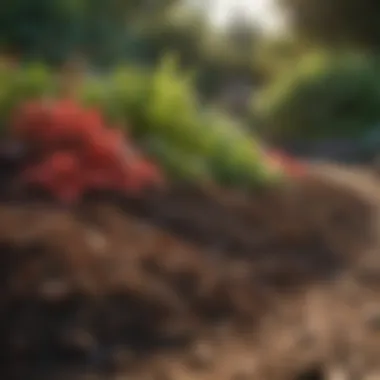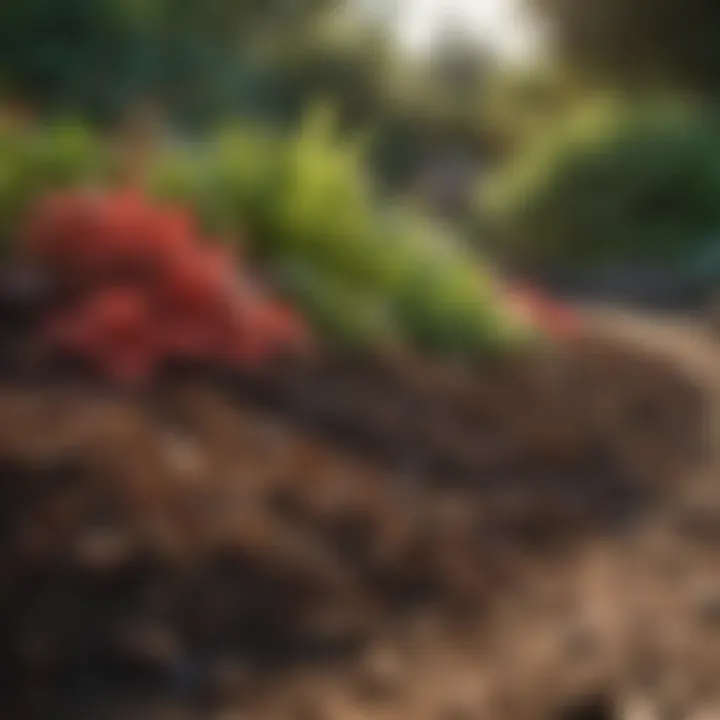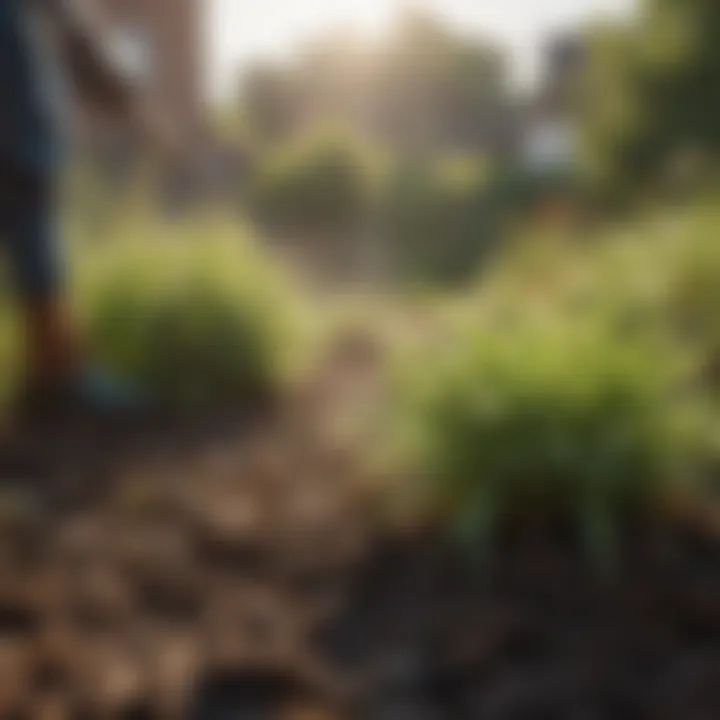Exploring Garden Mulch: Enhance Productivity & Sustainability


Intro
Mulching is an essential practice in gardening and agriculture, serving multiple purposes that enhance productivity and sustainability. It can significantly improve soil health while conserving moisture and suppressing weeds. This article aims to provide a comprehensive understanding of garden mulch, covering its types, benefits, and various applications. By understanding mulch better, both novice and seasoned gardeners can make informed decisions that align with ecological principles.
Overview of the Topic
Definition and Importance
Garden mulch is a protective layer placed on top of the soil in gardens and landscapes. Its importance cannot be overstated. It helps control soil temperature, maintains moisture, and reduces erosion. While these functions support plant health, they also contribute fundamentally to long-term environmental sustainability.
Current Trends
Recently, there has been a growing interest in organic mulches, such as wood chips and straw. These materials not only provide the aforementioned benefits but also contribute to soil fertility as they decompose. Furthermore, many gardeners are turning to biodegradable options to minimize waste and improve eco-friendliness in their practices. There is also more focus on mulching techniques that consider specific plant needs and local climate conditions.
Key Techniques and Practices
Step-by-Step Guide
- Choose Your Mulch: Depending on your garden's needs, select from organic options like wood chips, straw, or grass clippings. Synthetic options, such as plastic or rubber mulch, may also be considered but have different environmental impacts.
- Prepare the Area: Clear the garden bed of weeds and debris to create a clean surface for mulching.
- Apply Mulch: Spread mulch evenly, ensuring a thickness of about two to four inches. This depth helps with moisture retention and weed suppression.
- Monitor and Maintain: Regularly check the mulch layer for thickness and replenish it as needed, especially after heavy rains or wind.
Tools and Equipment Needed
- Garden rake: For leveling the mulch.
- Shovel: To move mulch from the pile to the garden bed.
- Gloves: To protect your hands while working with mulch.
- Tarps: For easy transportation of mulch and to keep your area tidy.
Challenges and Solutions
Common Obstacles
Two significant challenges in mulching are weed growth underneath the mulch and the attraction of pests. Improperly applied mulch can sometimes become a hiding place for certain insects, leading to infestations. Additionally, mulches that retain too much moisture can encourage fungal diseases.
Innovative Solutions
- Weed Barriers: Use a layer of cardboard or landscape fabric beneath the mulch to combat weeds effectively.
- Integrated Pest Management: Employing biological control methods can help manage pest issues while promoting a healthier garden ecosystem.
"Utilizing mulching as a technique is crucial for maintaining garden productivity without compromising sustainability."
By gaining familiarity with these aspects of garden mulch, farmers and gardening enthusiasts can enhance their practices and foster sustainability in their growing environments. The journey towards a healthier garden begins with informed choices and practical strategies.
Prolusion to Garden Mulch
Garden mulch plays a crucial role in horticultural practices. It helps in cultivating plants and improving the overall health of the garden. Understanding garden mulch is essential for both novice and expert gardeners. This section will provide an in-depth look at what garden mulch is, its historical significance, and its benefits in contemporary agriculture.
Definition of Garden Mulch
Garden mulch is any material used to cover the soil surface around plants in a garden. The primary purpose of mulch is to protect the soil and plants. Common materials include organic options like wood chips, straw, and grass clippings, as well as inorganic materials such as plastic and stone. By covering the soil, mulch conserves moisture, suppresses weeds, and regulates soil temperature. It becomes an integral tool for enhancing plant growth and maintaining soil health. Choosing the right type of mulch can lead to more productive gardens and sustainable practices.
Historical Context of Mulching
Mulching has a long history that dates back to ancient agricultural practices. Early civilizations recognized the benefits of covering their soil to protect crops from harsh weather conditions. In milder climates, straw and leaves were commonly used. Over the years, the methods and materials have evolved significantly. In modern times, with the rise of sustainable farming, mulching has regained popularity. Now it is implemented in numerous farming techniques, enhancing both productivity and ecological balance. The historical perspective reveals how indispensable mulching has been in agricultural development throughout time.
Types of Garden Mulch
Understanding the types of garden mulch is essential for any gardener interested in improving productivity and sustainability. Each type of mulch has unique characteristics, benefits, and drawbacks that can significantly affect the garden ecosystem. Proper selection is vital not only for plant health but also for efficient resource use. This chapter addresses organic and inorganic options, providing insights into their specific contributions in diverse gardening contexts.
Organic Mulch Materials
Organic mulches are derived from natural materials and contribute to soil health as they decompose. They enhance the structure of the soil, enrich it with nutrients, and encourage microbial activity. Here are some popular options among organic mulches.
Wood chips
Wood chips are a widely used organic mulch choice. One of their key characteristics is their durability, as they break down slowly compared to other organic materials. This slow decomposition makes them a beneficial choice for long-term mulching.
A unique feature of wood chips is their ability to retain moisture in the soil, thus reducing the need for frequent watering. However, they can also tie up nitrogen in the soil as they decompose, which is something to be aware of for nitrogen-sensitive plants.
Straw
Straw is another effective organic mulch material. It is valued for its lightweight and airy structure, which allows for good water retention while preventing soil compaction. Straw provides excellent insulation around plants, protecting roots from extreme temperature fluctuations.
However, straw can sometimes introduce weed seeds if not properly sourced. Therefore, using certified weed-free straw is important to avoid this issue.
Grass clippings


Grass clippings are often readily available and can be a free option for mulching. Their primary characteristic is their high nitrogen content, which can enrich the soil as they decompose. Grass clippings form a dense layer that effectively suppresses weeds and retains moisture.
A drawback is that if applied too thickly, they can mat down, preventing air circulation and potentially leading to poor drainage. It is advisable to layer grass clippings rather than applying them too densely.
Compost
Compost is one of the most effective organic mulches. It is rich in nutrients and enhances soil fertility. Using compost as mulch contributes significantly to soil health as its microbial activity enriches the ecosystem.
One unique aspect of compost is its versatility. It can be made from kitchen scraps and yard waste, making it an eco-friendly choice. However, it can sometimes have a strong odor, especially if not fully matured, and that is worth considering, especially in residential areas.
Inorganic Mulch Options
Inorganic mulches, on the other hand, do not decompose and can provide a different set of benefits and drawbacks. They typically require less maintenance and can serve unique purposes depending on the gardening context. Below are some common inorganic mulch options.
Plastic mulch
Plastic mulch is known for its effectiveness in warming the soil and controlling weeds. Its major advantage is its long-lasting nature, as it does not break down over time. This makes it an attractive choice for many farmers looking for low-maintenance solutions.
However, a significant drawback of plastic mulch is that it tends to restrict soil aeration and may prevent the penetration of water if not installed correctly. Additionally, it does not contribute to soil health in the same way organic options do.
Fabric landscape cloth
Fabric landscape cloth provides a balance between durability and functionality. Its key characteristic is permeability, allowing water and air to pass through while preventing weed growth. This can be particularly useful in garden beds and around perennials.
One unique feature of fabric mulch is that it can be easily cut and shaped, making installation flexible for various garden layouts. But fabric options do require periodic maintenance, as they can become clogged with soil or organic material over time, reducing their effectiveness.
Stone or gravel
Stone or gravel is often used in decorative gardens and xeriscaping. Its primary advantage is its aesthetic appeal, providing a clean, organized look. It helps in draining excess water and is highly durable, requiring minimal maintenance.
On the downside, stone or gravel does not add nutrients to the soil. It can also retain heat, which may not be suitable for all plant types.
Benefits of Using Garden Mulch
Garden mulch serves vital roles in horticulture, yielding numerous benefits that can greatly enhance productivity and sustainability. The application of mulch is not merely a cosmetic addition to gardens; it is a strategic practice that can transform soil health and plant growth. Understanding the key advantages of using mulch is essential for both novice and experienced gardeners. The following sections detail the specific benefits of mulch, highlighting its importance in garden management.
Moisture Conservation
One of the primary benefits of garden mulch is moisture conservation. Mulch acts as a barrier that reduces evaporation from the soil surface, helping retain necessary water. This is especially important in areas subject to hot climates or during prolonged dry spells. By minimizing water loss, mulch ensures that plants receive consistent moisture levels, promoting healthier root systems.
Additionally, mulching can reduce the frequency of irrigation needed. With lower evaporation rates, gardeners can save time and resources. A study mentioned in various sources suggests that mulch can reduce water usage by up to 50%. This is particularly relevant for sustainable gardening, as it conserves a precious natural resource while supporting plant health.
Weed Suppression
Mulch also plays a critical role in weed suppression. By creating a physical barrier over the soil, mulch inhibits the growth of competing weeds. This reduces the need for chemical herbicides, aligning with environmentally friendly gardening practices. The thickness of mulch can affect its effectiveness; a layer of about two to four inches is generally recommended.
Moreover, mulch not only prevents weed seeds from germinating but also helps to smother any existing weed growth. With less competition for nutrients and space, cultivated plants can thrive without the distraction of unwanted weeds. This leads to better yields and an overall healthier garden ecosystem.
Soil Temperature Regulation
Soil temperature regulation is another significant benefit of garden mulch. The insulating properties of mulch help maintain more constant soil temperatures. In cooler weather, mulch retains heat from the sun, protecting plant roots from frost and extreme cold. Conversely, during hot periods, it helps to keep the soil cooler, preventing stress to plants.
This thermal insulation contributes to a stable growing environment. Plants that are not subject to drastic temperature changes are more likely to exhibit vigorous growth. Furthermore, certain mulch materials can have additional thermal benefits. For example, black plastic mulch absorbs heat, making it beneficial in warmer climates to encourage earlier plant growth.
Nutrient Enrichment
Finally, the nutrient enrichment aspect of garden mulch is crucial for sustainable gardening. Organic mulches, such as wood chips and straw, break down over time, releasing nutrients back into the soil. This decomposition process improves soil fertility and enhances microbial activity, contributing to a rich ecosystem in the garden bed.
Additionally, the ongoing addition of organic matter helps to improve soil structure, which is essential for root development and overall plant health. As mulch decomposes, it also aids in the formation of humus—a component that enhances soil's water retention and nutrient-holding capacity.
"Effective mulching not only boosts productivity but fosters a sustainable gardening practice that benefits the entire ecosystem."
In summary, the benefits of using garden mulch are multi-faceted. From conserving moisture to providing a competitive edge against weeds, regulating soil temperature, and enhancing soil nutrients, mulch is an indispensable tool in modern gardening. By understanding these advantages, gardeners can make informed choices that align with both their productivity goals and sustainable practices.
How to Choose the Right Mulch
Selecting the appropriate mulch for your garden is critical for achieving optimal growth and sustainability. The right choice can enhance moisture retention, suppress weed growth, and improve soil health. Given the variety of options available, understanding the specific characteristics of each type of mulch is essential. This section will cover the most important considerations for choosing the right mulch, which includes plant type, environmental factors, and budget availability.
Plant Type Considerations
When selecting mulch, one must consider the specific needs of the plants being cultivated. Different plants have varying requirements for moisture, nutrients, and light, which can influence the effectiveness of the mulch used. For instance, organic mulches like straw and compost are often favored for vegetable gardens as they contribute nutrients back into the soil as they decompose.


Conversely, inorganic options like stone or gravel are more suitable for dry, drought-resistant gardens. These materials provide excellent drainage and weed suppression without altering soil composition over time. If you have flowering plants or ornamental shrubs, consider using shredded bark or wood chips. These materials not only suppress weeds but also enhance the aesthetic appeal of the landscape. Understanding the water and nutrient needs of your plants will guide you to a suitable mulch choice.
Environmental Factors
The surrounding environment plays a significant role in the effectiveness of mulch. Variations in climate, soil type, and local ecology must be taken into account. For example, in hot and arid regions, using a mulch that reflects sunlight can help in keeping the soil cool and retain moisture. Materials such as white or light-colored gravel may be preferable in such conditions.
Additionally, consider how rainwater drains in your garden. In areas with heavy rainfall, a mulch that compacts easily may trap water against plant roots, leading to rot. On the other hand, in sandy soils, a heavier organic mulch may be beneficial to help retain moisture. Understanding these environmental nuances will ensure that the mulch you select aligns with the specific conditions of your garden.
Budget and Availability
Finally, budget constraints and the availability of mulch types must be assessed. Organic mulches can often be sourced from local landscaping businesses or even created from yard waste, making them economical choices. However, some organic options can be premium-priced, such as cocoa hulls or cedar bark, due to their aesthetic appeal and pest-repelling properties.
In contrast, many inorganic mulches may be more expensive but require less maintenance over time. When selecting mulch, consider the long-term costs associated with maintaining the garden as well. It may be worthwhile to invest in higher-quality mulch that will last longer and requires less frequent replacement.
Important Tip: Always compare local suppliers for prices and check if they offer bulk discounts. This strategy can save significant amounts of money over time while ensuring you have access to high-quality mulch.
By weighing these considerations thoughtfully, gardeners can make informed choices about mulch that will promote plant health, conserve resources, and support sustainable gardening practices.
Application Techniques for Garden Mulch
Applying mulch correctly is critical for achieving the maximum benefits in gardening. The techniques used for mulching not only affect the visual appeal of a garden but also significantly influence the health of the plants, the soil, and the entire ecosystem. Proper application ensures that the mulch performs its intended functions efficiently such as moisture retention, weed suppression, and temperature regulation. Therefore, understanding the nuanced practices of mulch application becomes essential for any gardener aiming for productivity and sustainability.
Preparation of the Soil
Preparing the soil before applying mulch is a foundational step that should not be overlooked. First, ensure that the soil is nutrient-rich, which can significantly enhance mulch effectiveness. This involves removing any existing weeds and debris from the garden bed. If the soil is compacted, loosening it with a spade or garden fork will help facilitate water absorption and root growth. When the soil surface is clear and aerated, it allows the mulch to settle evenly and provide optimal insulation and moisture retention. Moreover, if organic mulch is used, enriching the soil with compost or fertilizer can promote microbial activity, which in turn enriches the soil over time.
Layering and Thickness Guidelines
The thickness and layering of mulch matter substantially in its performance. Generally, a layer of 2 to 4 inches is recommended, depending on the type of mulch used. Organic mulches, such as straw or wood chips, can be applied thicker, likely around 3-4 inches, as they break down gradually and enrich the soil. In contrast, inorganic mulches, like landscape fabric, should be applied thinner, at about 2 inches, to allow for proper drainage and air circulation.
When applying mulch, it is crucial to keep it a few inches away from plant stems or trunks. This practice helps prevent rot and pest attraction. Additionally, creating a slightly raised ring of mulch around plants improves moisture retention while still maintaining airflow to the base of the plants.
Maintenance Practices
Mulch does not just require initial application; it also demands regular maintenance. This involves periodic checks to ensure the mulch is in good condition. Organic mulches degrade over time, so it is vital to replace or replenish them at least once a year. This not only maintains its functionality but also keeps the aesthetic aspect of the garden vibrant.
Another critical maintenance task is monitoring for weed growth. While mulch suppresses many weeds, some hardy species may still penetrate it. Regular inspection and timely removal of these weeds help prevent them from establishing themselves within the garden bed. Furthermore, post-application, it is essential to check the effectiveness of mulch in moisture retention. Adjustments may be made in terms of thickness or material choice based on observed moisture levels.
"Proper mulching not only boosts plant growth but also helps in sustainable gardening practices, making it essential for all gardening endeavors."
Adopting these application techniques will ensure that your garden thrives while promoting an environmentally friendly approach to agriculture.
Common Misconceptions About Mulching
Mulching plays a significant role in gardening and agricultural practices. However, misconceptions about what mulch can and cannot do persist among both novice and experienced gardeners. Understanding these misconceptions is crucial because they can hinder proper mulching practices. This section addresses the common myths and misunderstandings around mulching, thereby equipping readers with accurate knowledge to make informed decisions in their gardening efforts.
Myths Regarding Organic Mulch
One prevalent myth about organic mulch is that it is always better than inorganic options. While organic materials such as wood chips, straw, and grass clippings break down over time, enriching the soil with nutrients, they also decompose at varying rates and can create different challenges. For example, if not managed well, they may attract pests or lead to fungal growth. Furthermore, organic mulch may require more frequent replenishment compared to inorganic types, which do not decompose.
Another common belief is that organic mulch eliminates the need for watering entirely. While mulch helps retain moisture in the soil, it does not replace the need for regular watering. In hot and dry conditions, even mulched plants must be watered to maintain optimal health. Thus, understanding that organic mulch is a complementary practice, rather than a standalone solution, is essential for successful gardening.
Misunderstandings About Inorganic Mulch
Inorganic mulch, such as plastic films or rocks, is often perceived as ineffective in improving soil health. However, this view is misleading. While inorganic options do not contribute nutrients like organic mulch, they serve to conserve moisture and suppress weeds efficiently. These mulches can provide a barrier against soil erosion and can be particularly useful in areas with extreme weather conditions where soil quality may be compromised.
Many gardeners also think that using black plastic mulch is harmful to the environment. Although black plastic does not biodegrade, it can still be part of a sustainable strategy. It can effectively warm the soil in cooler climates and suppress weed growth, leading to higher productivity for crops. Proper disposal methods after use can mitigate any adverse environmental impact.
Proper knowledge of mulch types is key to maximizing gardening success. Understanding how each type functions lets gardeners tailor their practices for the desired outcomes.
Epilogue
Overall, debunking myths and clearing misunderstandings around both organic and inorganic mulching practices allows gardeners to realize the true benefits of these methods. By recognizing that each type of mulch has unique characteristics, gardeners can implement them with better results in enhancing their gardens' productivity and sustainability.
Environmental Impact of Mulching
The practice of mulching in gardening and farming goes beyond aesthetic benefits or simple soil management. It plays a vital role in fostering a healthier environment, contributing significantly to both soil health and local ecosystems. Understanding these impacts allows gardeners and farmers to make choices that not only benefit their crops but also enhance the broader ecological landscape.
Contribution to Soil Health
Mulching directly influences soil health by promoting various natural processes. The layer of mulch serves as an insulator, maintaining temperature and moisture levels that are crucial for soil organisms. For example, during hot weather, organic mulches can keep the soil cooler, thereby protecting beneficial microbes which thrive in specific temperature ranges.


Furthermore, as organic mulches, such as straw or wood chips, degrade, they release nutrients back into the soil. This breakdown fosters a rich nutrient cycle, improving overall soil fertility. The addition of mulch also enhances soil structure, contributing to better aeration and moisture retention. This is particularly essential in sandy soils, where water can quickly drain away. Regular mulching can prevent soil erosion by protecting the soil surface from rain impacts.
"Mulching forms a barrier that reduces soil disturbance and promotes health, which is key for sustainable practices."
Maintaining diverse mulch materials can lead to an enriched microbial environment. A balance of brown materials, rich in carbon, and green materials, high in nitrogen, can create a thriving ecosystem that further enhances soil biodiversity.
Effects on Local Ecosystems
The impact of mulching extends to local ecosystems as well. When mulching materials like leaf litter and grass clippings are recycled, they can support fauna ranging from earthworms to beneficial predatory insects. These organisms contribute to pest control and nutrient cycling, promoting a balanced ecosystem.
Additionally, mulching reduces the need for chemical herbicides and fertilizers, which can leach into water systems, causing pollution. By using mulch for weed control, garden and farm managers minimize chemical use and promote a healthier environment. This is particularly important in urban areas, where runoff can rapidly affect water quality in nearby lakes and rivers.
Mulching also provides habitats for various wildlife. Small creatures, such as insects and rodents, find refuge within mulch layers, which can help sustain local food webs. The appeal of natural landscapes to pollinators can enhance biodiversity, crucial for thriving gardens and farms.
Case Studies: Successful Mulching Practices
Understanding successful mulching practices is integral to maximizing the advantages of garden mulch. Case studies provide tangible examples of the benefits of proper mulching techniques. They showcase how various gardeners and farmers have harnessed the potential of mulch to improve productivity and sustainability. The insights from these practical applications allow both novice and experienced gardeners to draw inspiration and learn valuable lessons for their own practices.
Urban Gardening Applications
Urban environments pose unique challenges for gardeners. Limited space and compacted soil conditions often hinder plant growth. Case studies involving urban gardening utilize mulch effectively to combat these issues. For instance, community gardens have implemented organic mulch like grass clippings and wood chips. These materials help in retaining soil moisture and regulating temperature in a densely populated environment.
A notable urban case is the Green Roof Movement, where extensive systems involve layering mulch to support plant health. The use of mulch on roofs helps to mitigate urban heat effects and allows for rainwater retention. Such practices demonstrate that even in limited spaces, mulching can create sustainable mini-ecosystems. The implementation of mulch in urban settings also encourages biodiversity and enhances aesthetic value, which is essential in cities.
Rural Farming Techniques
In rural settings, mulching plays a pivotal role in enhancing agricultural productivity. Many farmers adopt techniques that utilize organic and inorganic mulch options. Research indicates that straw mulch in row crops can significantly reduce weed growth while promoting soil fertility. A striking example is the no-till farming approach, where layers of mulch are utilized to protect soil structure and moisture.
Farmers using plastic mulch have shown dramatic improvements in crop yields, especially in warmer climates, by enhancing temperature control and moisture availability. The emphasis on mulching in these case studies reveals the significance of tailored approaches aligned with specific crop needs and environmental conditions.
Furthermore, these case studies highlight the importance of continuous improvement. Farmers often share their experiences through workshops or local agricultural forums, leading to innovations in mulching techniques that become adopted widely.
Highlighting these practical examples enhances understanding of mulching’s versatility and encourages proactive learning among garden enthusiasts and agricultural practitioners.
Effective mulching engagements, as seen in these case studies, underscore its critical role in both urban and rural ecosystems.
Future Trends in Mulching
As the gardening industry evolves, so do the methods and materials employed in mulching. This section examines the significance of future trends in mulching, highlighting innovations and the integration of technology. These developments not only aim to enhance productivity but also bolster sustainability in horticultural practices.
Innovations in Mulch Materials
The advent of new mulch materials is reshaping traditional mulching practices. These innovative materials focus on functionality, longevity, and environmental friendliness. One example is biodegradable mulch films made from corn starch or other natural polymers. Unlike conventional plastic mulches, these options break down naturally, thus reducing waste and eliminating the need for removal after the growing season.
Another notable advancement is the use of engineered wood products. Recycled wood from construction waste is being processed into refined mulch that offers both aesthetic appeal and long-term benefits to the soil. The inclusion of mycorrhizal fungi in these wood-based mulches can substantially improve soil microbial health, enhancing nutrient cycling and plant growth.
Furthermore, stirring interests in local sourcing strategies is emerging. Gardeners are now considering regionally sourced materials, reducing transportation emissions and promoting local economies. Options like cotton gin waste or sugarcane leftovers not only serve as effective mulch but also support sustainable agricultural practices.
Integrating Mulch with Technology
The integration of technology in gardening practices is becoming more prevalent, and mulching is no exception. Precision agriculture tools are now being applied to optimize mulch application processes. Sensors and data analytics can determine the content and moisture levels of soil, guiding gardeners on the precise times and amounts of mulch required. This targeted approach not only conserves resources but also enhances the effectiveness of mulching for soil health.
Additionally, automated irrigation systems linked with mulch layers can significantly improve water efficiency. Smart technologies monitor rainfall and moisture levels, adjusting irrigation accordingly. This alignment ensures that the mulch retains moisture effectively without over-irrigation, promoting healthy root systems.
Lastly, the use of mobile apps for gardeners is on the rise. These apps help individuals track their garden care routines, including mulching intervals and types. By providing real-time monitoring and reminders, technology assists even novice gardeners in maintaining best practices, ultimately leading to healthier plants and more productive gardens.
"The future of mulching is not just in the materials we use but also in how we can leverage technology to make our practices more efficient and sustainable."
Culmination
The role of garden mulch is integral in sustainable agriculture, supporting both productivity and ecological balance. As we have explored throughout the article, the benefits of utilizing mulch extend beyond mere aesthetics. Garden mulch serves as a crucial component in improving soil health, conserving moisture, and suppressing weeds, which are essential elements for successful gardening.
Summary of Key Points
In summary, the key points discussed in this article include:
- Various types of mulch, such as organic materials like wood chips and inorganic options like plastic mulch, provide different benefits and applications depending on the gardening context.
- Benefits of using garden mulch encompass moisture conservation, weed suppression, and soil temperature regulation, which ultimately enhance plant growth.
- Important considerations when selecting mulch include plant type, environmental factors, and budget constraints. This careful selection can lead to optimal gardening results.
By understanding these aspects, gardeners can make informed decisions that align with their specific needs and conditions, fostering healthier gardens.
The Future of Garden Mulch in Sustainable Practices
Looking ahead, the future of garden mulch appears promising, especially with ongoing innovations in material types and application methods. As the sustainability movement gains more traction, there is a growing demand for mulch materials that are not only effective but also environmentally friendly.
- Innovations such as biodegradable mulch films are emerging, offering alternatives that degrade over time while enhancing soil nutrition.
- Integration of technology, such as automated mulching systems, is also being explored. This can increase efficiency and effectiveness in both urban and rural settings.
These trends indicate a shift towards more sustainable practices in gardening, suggesting that mulch will continue to play a vital role in enhancing productivity and maintaining healthy ecosystems. The incorporation of scientific advancements will further refine mulching techniques, making it easier for gardeners to achieve their horticultural goals while contributing positively to the environment.
"Effective mulching is not just a method; it’s a commitment to sustainable gardening that benefits both the gardener and the planet."



